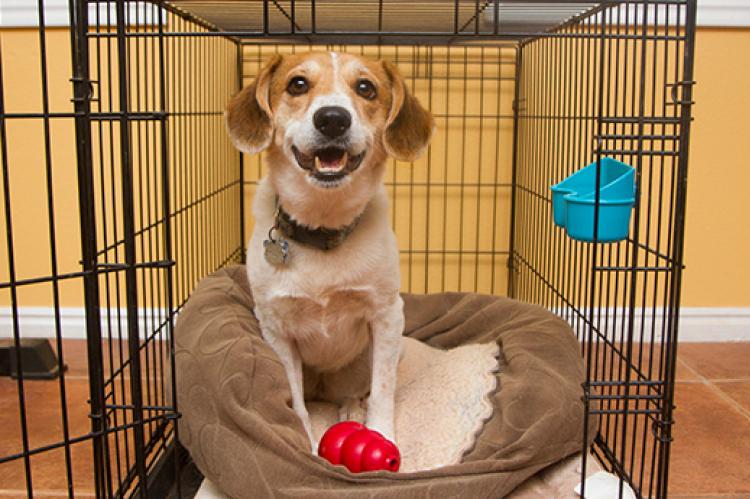
Crate Training: The Benefits for You and Your Dog
By Sherry Woodard, Best Friends animal behavior consultant
Why should I consider crate training my dog?
Dogs are hard-wired by their genetic history to be den animals. A den is a small, safe, well-defined space. It is a place in which dogs feel instinctively safe. It is also a place that they instinctively avoid soiling. The combination of these two native traits are what make crate training, done in the right way, a kind and effective component in house-training your new puppy or dog.
A crate can also be a place for your dog to rest or have “down time.” If you have just acquired a dog, a crate can limit access to the entire house until your new dog knows the house rules. A crate can help with house-training by setting up a routine. For example, you can feed the puppy in the crate and, afterwards, carry him or walk him on a lead straight out to an elimination site where you can use a word or phrase to remind the dog what the trip outside is for.
There are other benefits of crate training. At some point in your dog’s life, it may be necessary to use a crate when you are traveling with your pet or when your dog is recuperating from an injury. Such potentially traumatic situations will be much less stressful if your dog is already familiar with and comfortable in a crate. Crates are also useful for keeping destructive dogs out of mischief when you’re not home to keep an eye on them.
Where do I purchase a crate and how do I know which one to buy?
Most pet-supply stores carry dog crates; pet catalogs sell them as well. Considerations when buying your crate: Make sure the crate is big enough so that the dog can stand up, turn around and lay flat on his side in comfort, but small enough that there isn’t enough room for the dog to sleep and eat at one end and eliminate at the other. If you are training a growing puppy, you can buy a larger crate with a divider for adjusting the crate as he grows.
How do I introduce the crate?
You can prevent problems with crate training by setting your dog up for success. Your dog should only associate good things with the crate, so start by putting treats and/or toys in the crate and encouraging him to go in. Some dogs may need to warm up to the crate slowly. If your dog is afraid to go in, place a treat in the crate as far as he is willing to go. After he takes the treat, place another treat a little further back in the crate. Keep going until he is eating treats at the very back, then feed him his next meal in the crate with the door open, so that he can walk in and out at will. Crate training a fearful dog can take days, so be patient and encouraging. If a crate is properly introduced and used, your dog will happily enter and settle down.
Should the crate be used at night?
Sure, you can use the crate at night. Put the dog in with a treat and a cue like “kennel” or “kennel up” delivered in a cheery tone of voice. The crate should be situated close to you so that you can hear the dog whine or whimper if he needs to eliminate during the night. (Dogs will usually make some kind of noise rather than make a mess where they sleep.)
If you are training a puppy, be prepared for one or two trips outside at night to eliminate. If the puppy goes outside and doesn’t produce, do not allow any extra time for play or long drinks of water when you come back inside. Instead, encourage the pup to return to the crate. He may whine a bit, but if you have given him ample opportunity to eliminate, try to ignore the protest and the puppy should settle down quickly.
How much time in the crate is okay?
No dog, young or old, should be living in a crate full-time. Dogs are social animals, so for a dog to have a good quality of life, social isolation should be kept to a minimum. All dogs need daily exercise and some interaction with others. Even four hours in a crate without a break during the day is a long time for many adult dogs. If you must crate your dog when you’re not home, arrange to have someone stop in and let her out for a potty break and to stretch her legs. Except for nighttime, crating a dog for long periods of time is not advised.
Puppies, especially, should not be left in a crate for long periods of time (more than two hours). It is important that puppies not be neglected and forced to break their instinctive aversion to soiling their sleeping area. Unfortunately, this is what happens to many pet-store puppies and it can lead to serious house-training difficulties. Also, since they are still developing, puppies have even more need for social interaction than adult dogs. If they aren’t socialized to the world while they are young, they can develop fears and aberrant behaviors of many kinds.
Most adult dogs can stay in a crate for the entire night without a trip outside. However, young puppies and some old dogs cannot physically hold their bladders and bowels through the night.
When should a crate not be used?
A crate should not be used as a form of punishment. As mentioned earlier, your dog should have only warm, fuzzy feelings about her crate. Even though a dog can come to see her crate as a safe place, it is not the solution for a dog with separation anxiety, since she could injure herself trying to get out.
Method 1: Food lures and puzzles
Step 1: Place a few treats in the rear of the crate and leave the crate door open. When the dog is freely going in and out of the crate, go to Step 2. Tips:
- If he needs more encouragement, drop a trail of treats leading into the crate.
- If the dog won’t enter the crate for any treats, proceed to Method 2 below.
Step 2: In one motion, point to the crate and toss a treat from your pointing hand into the crate so that the dog goes into the crate to get it. Practice this 10 times and then go to Step 3.
Step 3: Do the same pointing motion, but this time don’t toss a treat from that hand. If the dog goes into the crate, praise him and give him a treat from your other (non-pointing) hand. Practice this 10 times.
- Tip: If he doesn’t go in when you merely point, go back and repeat Step 2.
Step 4: Standing next to the crate, say “crate” and then make the pointing motion to the crate. When the dog enters, praise him and give treats from the non-pointing hand. Practice this 10 times.
Step 5: Standing next to the crate, say “crate” and don’t make the pointing motion. Wait for the dog to go into the crate for the verbal cue only. Practice this 10 times. When the dog is going into his crate for the “crate” cue only, go to Step 6.
- Tip: If he doesn’t go in for the “crate” cue only, make the pointing motion to the crate. Keep working with him this way until you see that he’s starting to go in for the “crate” cue only and isn’t waiting for the pointing motion.
Step 6: When the dog enters the crate, briefly shut the door, then toss an extra-special treat (EST) into the crate. When the dog has finished eating it, toss another EST into the crate, open the door, and allow the dog to exit.
Step 7: Gradually increase the time that the dog is in the crate with the door closed. The easiest way to accomplish this is by giving the dog a food puzzle or frozen, stuffed Kong to occupy him while he’s in the crate. Always use an EST to reward the dog for going into the crate and right before coming out of the crate. When the dog can spend 15 minutes in the crate, go to Step 8.
Step 8: While the dog is in the crate, begin leaving the room for short periods of time. As in Step 7, give the dog a frozen Kong or food puzzle. You can also add a favorite toy or two to the crate, as well as blankets or other comfort items. Increase the amount of time until the dog can spend 30 minutes comfortably in the crate without someone there.
Method 2: Feeding meals in the crate
Step 1: Begin by placing the dog’s meal in a bowl as near to the crate as he will go.
Step 2: Gradually move the bowl closer to the crate over the course of a few meals.
Step 3: When the dog is relaxed about eating near the crate, begin placing the meal just inside the crate.
Step 4: Gradually move the meal toward the back of the crate.
Step 5: When the dog is entering the crate with his entire body, proceed to Step 1 of Method 1.
Proofing
Proofing means teaching the dog to generalize the behavior in different contexts.
Handler: Have different people give the dog the “crate” cue and reward him for going into the crate. If initially he doesn’t go in for the “crate” cue only, they should make the pointing motion after they give the cue.
Duration: Gradually increase the amount of time the dog spends in the crate, including leaving the house for a short period while the dog is in his crate working on his Kong or food puzzle. Do not crate a dog for more than four hours at a time, except at night.
Distractions: While the dog is in the crate, talk quietly in an adjoining room, and then gradually increase the volume and the number of people talking. You can also play music, turn on the TV or run appliances.
Location: If you will be traveling with your dog and his crate, when he is staying in the crate comfortably for hours, move it to other rooms of the house and have him stay in it there. If possible, bring your dog and his crate to a friend’s house and have him spend short periods in it there, then increase the duration. Repeat in other locations until your dog is comfortable in his crate wherever you take him.
Notes
Never force a dog into the crate. The goal of crate training is to make the crate a safe, happy place where the dog will want to go and spend time. If the dog appears anxious or unhappy about being in the crate at any point during training, back up in the plan to the previous step.
Don’t ever put the dog in the crate as punishment. Doing so may make the dog afraid of his crate, or it may even seem like a reward (since the crate is a place that he should love to go).
If you get stuck between steps, create an intermediate step with duration that your dog is comfortable with. Don’t rush: Take it at the dog’s speed.



Leave a Reply